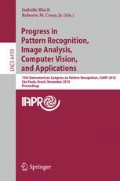Abstract
In this paper, we propose a novel texture analysis method using the complex network theory. It was investigated how a texture image can be effectively represented, characterized and analyzed in terms of a complex network. The propose uses degree measurements in a dynamic evolution network to compose a set of feasible shape descriptors. Results show that the method is very robust and it presents a very excellent texture discrimination for all considered classes.
Chapter PDF
Similar content being viewed by others
Keywords
These keywords were added by machine and not by the authors. This process is experimental and the keywords may be updated as the learning algorithm improves.
References
Antiqueira, L., Nunes, M.G.V., Oliveira, O.N., Costa, L.F.: Strong correlations between text quality and complex networks features. Physica A 373(1), 811–820 (2007)
Azencott, R., Wang, J.P., Younes, L.: Texture classification using windowed fourier filters. IEEE Transactions on Pattern Analysis and Machine Intelligence 19(2), 148–153 (1997)
Backes, A.R., Bruno, O.M.: Shape classification using complex network and multi-scale fractal dimension. Pattern Recognition Letters 31, 44–51 (2010)
Backes, A.R., Casanova, D., Bruno, O.M.: A complex network-based approach for boundary shape analysis. Pattern Recognition 42(1), 54–67 (2009)
Brodatz, P.: Textures: A photographic album for artists and designers. Dover Publications, New York (1966), http://www.ux.uis.no/~tranden/brodatz.html
Chalumeau, T., Costa, L.F., Laligant, O., Meriaudeau, F.: Texture discrimination using hierarchical complex networks. In: Proceedings of the Second International Conference on Signal-Image Technology and Internet-Based Systems, pp. 543–550 (2006)
Chalumeau, T., da Costa, L.F., Laligant, O., Meriaudeau, F.: Complex networks: application for texture characterization and classification. Electronic Letters on Computer Vision and Image Analysis 7(3), 93–100 (2008)
Chalumeau, T., da Costa, L.F., Laligant, O., Meriaudeau, F.: Texture discrimination using hierarchical complex networks. Multimedia Systems and Applications 31(2), 95–102 (2008)
Costa, L.F.: Complex networks, simple vision (2004), http://arxiv.org/abs/cond-mat/0403346
Costa, L.F., Rodrigues, F.A., Travieso, G., Boas, P.R.V.: Characterization of complex networks: A survey of measurements. Advances in Physics 56(1), 167–242 (2007)
Haralick, R.M.: Statistical and structural approaches to texture. Proceedings of IEEE 67(5), 786–804 (1979)
Julesz, B.: Experiments in the visual perception of texture. Scientific American 232(4), 34–43 (1975)
Kasparis, T., Charalampidis, D., Georgiopoulos, M., Rolland, J.P.: Segmentation of textured images based on fractals and image filtering. Pattern Recognition 34(10), 1963–1973 (2001)
Manjunath, B.S., Ma, W.Y.: Texture features for browsing and retrieval of image data. IEEE Transactions on Pattern Analysis and Machine Intelligence 18(8), 837–842 (1996)
Tuceryan, M., Jain, A.K.: Texture analysis. In: Handbook of Pattern Recognition and Computer Vision, pp. 235–276 (1993)
Author information
Authors and Affiliations
Editor information
Editors and Affiliations
Rights and permissions
Copyright information
© 2010 Springer-Verlag Berlin Heidelberg
About this paper
Cite this paper
Backes, A.R., Casanova, D., Bruno, O.M. (2010). A Complex Network-Based Approach for Texture Analysis. In: Bloch, I., Cesar, R.M. (eds) Progress in Pattern Recognition, Image Analysis, Computer Vision, and Applications. CIARP 2010. Lecture Notes in Computer Science, vol 6419. Springer, Berlin, Heidelberg. https://doi.org/10.1007/978-3-642-16687-7_48
Download citation
DOI: https://doi.org/10.1007/978-3-642-16687-7_48
Publisher Name: Springer, Berlin, Heidelberg
Print ISBN: 978-3-642-16686-0
Online ISBN: 978-3-642-16687-7
eBook Packages: Computer ScienceComputer Science (R0)





